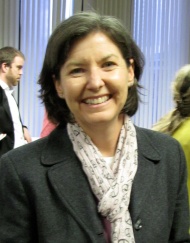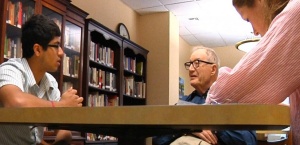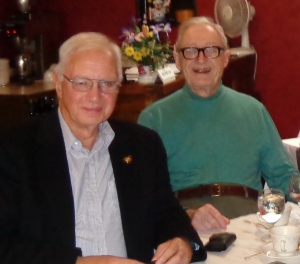
Atlanta, Georgia
Site of the 11th International Conference on Shaken Baby Syndrome/Abusive Head Trauma
September 2010
A bold article in the Utah Law Review by Prof. Joëlle Anne Moreno at the Florida International University College of Law and prosecutor Brian Holmgren in Tennessee not only dismisses the debate about shaken baby syndrome as a “false controversy” but also labels SBS defense experts as “mercenaries” and roasts Supreme Court Justice Ruth Bader Ginsburg for her dissenting opinion when the court reinstated the vacated conviction of grandmother Shirley Ree Smith in 2011.
“Dissent Into Confusion: The Supreme Court, Denialism, and the False ‘Scientific’ Controversy Over Shaken Baby Syndrome” explores a couple of topics I’ve heard Holmgren address in the past, and it reminds me of his rollicking presentation in Atlanta in 2010, which I will get to later in this posting. The Dissent paper correctly identifies the 1997 trial of British au pair Louise Woodward as a milestone in the arena, achieving far more than just bringing the syndrome into the headlines. Their analysis:
“The hotly contested trial also brought national attention to the use of highly paid defense medical witnesses to challenge the accuracy of a child abuse diagnosis and to advance outlier and highly controversial ‘alternative theories’ of causation… Woodward marks the origin of the false AHT/SBS controversy—at least in part because the defendant, who was convicted of second-degree murder by a jury, was later freed by the judge. This fact alone could explain the resulting public uncertainty regarding the weight of the prosecution’s medical evidence. Irresponsible journalists, however, including Mike Wallace of 60 Minutes, exacerbated the confusion.”
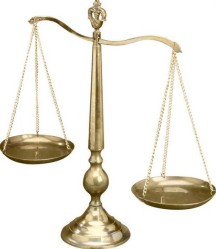 I agree that the Woodward trial brought a new kind of medical evidence to the courtroom, but I would call it a vital counterbalance to the common knowledge. The au pair agency that had placed the nanny, or possibly their insurance company, paid for first-rate attorneys who brought in experts with impeccable credentials. In his decision to set Woodward’s sentence at time served, Judge Hiller Zobel cited the nanny’s confusion, inexperience, and immaturity. I have to wonder if he wasn’t also influenced by the testimony of witnesses like biomechanics pioneer Lawrence Thibault, ScD, who had designed the experimental mannequins for the Duhaime research that raised the first scientific questions about shaking theory in the 1980s, and pioneering neurosurgeon Ayoub Ommaya, who had collaborated with Thibault long before the Duahime study. The televised trial certainly featured a more organized and better articulated defense than the 1997 trial that drew me into this arena, or any of the others I’ve researched from that era, especially Shirley Ree Smith’s.
I agree that the Woodward trial brought a new kind of medical evidence to the courtroom, but I would call it a vital counterbalance to the common knowledge. The au pair agency that had placed the nanny, or possibly their insurance company, paid for first-rate attorneys who brought in experts with impeccable credentials. In his decision to set Woodward’s sentence at time served, Judge Hiller Zobel cited the nanny’s confusion, inexperience, and immaturity. I have to wonder if he wasn’t also influenced by the testimony of witnesses like biomechanics pioneer Lawrence Thibault, ScD, who had designed the experimental mannequins for the Duhaime research that raised the first scientific questions about shaking theory in the 1980s, and pioneering neurosurgeon Ayoub Ommaya, who had collaborated with Thibault long before the Duahime study. The televised trial certainly featured a more organized and better articulated defense than the 1997 trial that drew me into this arena, or any of the others I’ve researched from that era, especially Shirley Ree Smith’s.
As in Woodward, the prosecution prevailed in Smith, only to see the defendant released after all, amid media coverage that seemed to imply innocence. Smith was convicted in 1997 but released in 2006, after the Ninth Circuit Court of Appeals vacated the jury’s decision. The Supreme Court reinstated her conviction in 2011, but the following spring California Gov. Jerry Brown issued a pardon, so Smith was not required to return to prison and finish her sentence. Moreno and Holmgren promise to set the record straight by dispelling what they see as two fundamental errors in the dissenting opinion to the Supreme Court decision: that Smith’s grandson Etzel Glass showed “few signs of SBS” and that “doubt has increased within the medical community regarding SBS.”
“Few signs of SBS”
As the Dissent paper concedes, the autopsy report says Etzel had subdural and subarachnoid bleeding but no brain swelling and no retinal hemorrhages. Doctors also found blood in the optic nerve sheaths, most of it “recent in origin” but with “occasional hemosiderin pigment deposits” that implied decomposed blood. Only one of these signs—subdural hematoma—is technically on the short list of defining SBS symptoms, although some sources include “subdural or subarachnoid” bleeding, as both are a common result of impact injury, except that subarachnoid bleeding has more known non-traumatic causes than subdural bleeding.
At Smith’s trial, forensic pathologist Dr. Stephanie Ehrich, her supervisor Dr. Eugene Carpenter, and child-abuse pediatrician Dr. David Chadwick all testified that Etzel had died of a shaking assault that tore his brainstem, causing death so immediate that there was no time for the usual signs of SBS to develop. But autopsy revealed no evidence of any tearing, which apparently Erlich believed to be within the brainstem, which she didn’t examine. Moreno and Holmgren write:
“Dr. Erlich noted that she did not submit sections of Etzel’s brainstem for microscopic examination because injury would not be evident on microscopic examination if the child died quickly, and this would not have assisted in her diagnosis because the examiners ‘wouldn’t have found anything anyway.'”
The authors note that the “medical construct” of AHT “can include subdural hemorrhage, retinal hemorrhage, encephalopathy, and often evidence of previous trauma or other bodily injury.” Granted that Etzel had two items on this list, subdural hematoma and evidence of previous trauma, the overall picture is still short two out of three defining features for SBS. The authors do convince me that they and the prosecution experts all sincerely believe Etzel was shaken to death, but I can identify only one leg of the triad and no reason to conclude that Shirley Smith was responsible for her grandson’s collapse. Did Etzel really cry long and hard enough that his grandmother snapped and shook him to death while his mother, asleep in the next room, never heard a thing?
“Doubt Has Increased”
The Dissent paper also blasts the Edmunds decision, which triggered the 2009 critique of shaken baby in the courtroom by law professor Deborah Tuerkheimer and appears in articles like the 2012 paper by Keith Findley et al. The authors explain:
“Justice Ginsburg notably did not cite any of these law review articles. However, because her opinion closely mirrors these works, she grants an unwarranted imprimatur of legitimacy to legal academic arguments that SBS ‘quite possibly does not exist,’ may be ‘junk science,’ that ‘SBS science in its current conflicted state . . . does not support criminal convictions,’ and that the medical community has ‘deliberately discarded a diagnosis defined by shaking.'”
Moreno and Holmgren attribute the imaginary debate about shaken baby syndrome to a small cadre of “self-interested and highly-paid defense witnesses” who “fundamentally misconstrue and misstate the basic science involved in the medical diagnosis of child abuse” and whose views are then parroted by academics:
“The academics cite the same handful of defense medical witnesses, the media cites both, the defense medical witnesses benefit from the publicity and are hired in more cases, and the cycle begins anew.”
Holmgren elaborated on this theme at the 2010 NCSBS conference, in a multimedia presentation that illustrated how effective he must be in front of a jury. He projected a series of quotes from defense expert testimony while Pinnochio’s nose grew on a larger screen behind him. He charged the witnesses with giving conflicting opinions at different times, misrepresenting their qualifications, misquoting the literature, publishing case studies without revealing their roles as defense witnesses, publishing cases of alleged mimics without revealing that abuse was confirmed by a conviction, and “making blatantly false statements.” 
The session ended with a sing-along, led by guitar-playing child-abuse pediatrician Dr. John Stirling from Santa Clara County. The song was “If I Only Get Ten Grand” (words here), sung to the tune of “If I Only Had a Brain,” with the message that defense experts are in it for the money. I can speak only from my own experience, but the professionals I know who defend against shaking allegations could be earning a lot more and enduring a lot less flak by staying away from the controversy. And most defendants are having trouble paying the rent in the face of lost income and unexpected legal costs, let alone finding the money for expensive experts.
Holmgren also foreshadowed parts of the Disssent paper in his presentation on the Smith case at the 2012 NCSBS conference, “SBS and the Supreme Court,” in conjunction with child-abuse pediatrician Dr. Randell Alexander. Holmgren opened his segment with a review of the appeals: Smith was convicted in 1997, and her first appeal was rejected in 2000. Her 2006 habeas petition was denied by a district court, but the Ninth Circuit Court of Appeals reversed that decision. “This always bothers me,” Holmgren said about multiple appeals, “as if the jurors are too stupid to get it right, as if the district attorney is too stupid to get it right.” The Supreme Court reversed the Ninth Circuit twice, in 2007 and 2010, but the Ninth Circuit stuck by its decision. “The Supreme Court keeps slapping them down like an unruly child,” Holmgren noted.
Finally, in 2011, the Supreme Court definitively reversed the Ninth Court’s 2006 ruling, and Smith’s conviction was reinstated, but with the problematic minority opinion. Holmgren stepped through the literature cited in the footnotes—Donohoe 2001, Bandak 2005, Leestma 2006, and so on—dismissing each in turn, and indignant that a justice of the supreme court would be getting her information from defense experts. His conclusion with Moreno in the Dissent paper confirms that Holmgren is holding strong to that position:
“The Smith dissenters’ myopic view of the evidence muddies their analysis of the legal and scientific questions and raises real concerns about the message sent to future courts, the media, and the public.”
I don’t see how the Dissent paper is gong to enhance either understanding or justice in these cases, as I think we need to be learning more about infant head injury, not setting up barricades against further discussion. ©2014 Sue Luttner If you are not familiar with the debate surrounding shaken baby syndrome, please see the home page of this site.






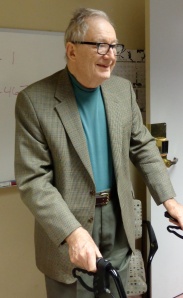

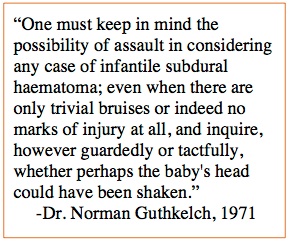

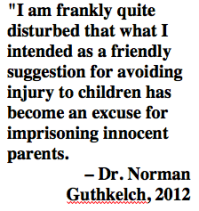 He stayed in the field until 1992, as improvements in medical imaging and surgical technique transformed the way doctors diagnose and treat problems of the brain. Neurosurgeons were collaborating with radiologists as they honed their abilities to decipher the lights and shadows of CT scans and MRIs. “I loved every minute of it,” he beams.
He stayed in the field until 1992, as improvements in medical imaging and surgical technique transformed the way doctors diagnose and treat problems of the brain. Neurosurgeons were collaborating with radiologists as they honed their abilities to decipher the lights and shadows of CT scans and MRIs. “I loved every minute of it,” he beams.
